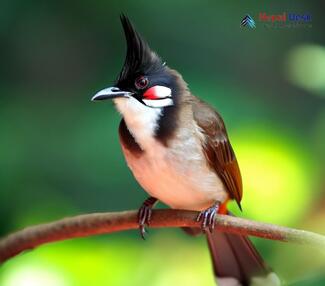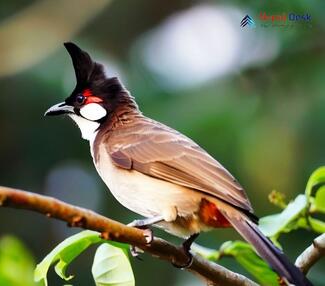The red-whiskered bulbul (Pycnonotus jocosus) is a distinctive songbird native to Asia and easily identified by the red streaks under its eyes resembling whiskers. Around 20 cm long with a pointed black crest, their smooth feathers appear brown-olive above, brightening to pale underparts with bold black and white tail bars.
First described by Linnaeus in 1758, these lively birds fill jungle habitats across Nepal with melodious yet sneering call notes sounding like “procs proc proczeee” fading upwards.
The red-whiskered bulbul belongs to the Pycnonotidae family of bulbuls under the Passeriformes bird order. Their genus Pycnonotus contains over 50 old-world bulbul species - mostly tropical Asian in range - with taxonomic relationships still being revised based on genetic analysis.
The red-whiskered bulbul is considered a resident suburban adapter flourishing near human habitation across Nepal up to 2100m elevation.
Habitat and Distribution
Natural Habitats
In Nepal, red-whiskered bulbuls occupy diverse habitats from steamy riverine jungle to temperate oak forests and rhododendron woodlands. Though widespread across suitable subtropical climates of the Terai and Siwalik Hills, they thrive most prolifically around human cultivation – frequenting gardens, orchards, city parks, and farmlands across Kathmandu Valley up to 2100 meter elevations.
Geographic Range
The global range of red-whiskered bulbuls extends from the western Himalayas across the Indian subcontinent and southeast Asia. In Nepal, they reside year-round as common generalists across most of the country up to lower montane zones – with local migrations tracking seasonal fruits and flowers. Birdwatchers can readily find these vocal and acrobatic birds hopping branches in their busy quest for berries and nectar from lowland grasslands to Mid-Mountain hill stations.
Behavior and Lifestyle
Diet and Feeding Habits
Red-whiskered bulbuls enjoy diverse fruit and flower diets - feasting upon mangos, guavas, berries, nectar, and easily-accessible seed crops. Their upward-curved beaks evolved perfectly for plucking fruits directly off branches.
Flocks noisily squabble overripe fig and pipal tree fruits. Alternatively, solitary bulbuls thoroughly work dense flowering bushes seeking varied sustenance. Such adaptive generalist feeding gives red-whiskered bulbuls advantages over other bird species - enabling thriving numbers near human cultivation.
Social Behavior
Though aggressive in defending feeding territories, red-whiskered bulbuls congregate in social, noisy flocks - likely bolstering overall vigilance against predators. Their flocks mix freely, likely fluidly exchanging information on optimal nearby food sources.
Pairs vigorously guard nesting sites, but may gather in groups of hundreds at dusk to roost communally. Such highly adaptive sociality combines with anatomical assets optimizing the agile red-whiskered bulbul’s proliferation across the diverse climates of Nepal and beyond.
Breeding and Nesting
Mating Rituals
Beginning in spring, male red-whiskered bulbuls vigorously defend breeding territories through loud birdsong sometimes lasting over 3 hours nonstop to attract females. Once bonded, pairs partake in courtship feeding rituals where the male presents seeds or fruits to the female while bobbing his body and fanned-out tail.
Following copulation sealed by duetting duos singing tightly-synchronized warbling tunes, a surge of key reproductive hormones facilitated by tactile preening and allopreening social bonding behaviors between pairs likely help trigger ovulation and prime successful breeding attempts.
Nesting Habits
The female constructs a delicate cup-shaped nest woven from dry leaves, twigs, and grasses. She lays 2 to 4 eggs over successive days, incubating them for 13-14 days while the male guards and occasionally feeds her. Both parents share extensive chick-rearing duties for the next two weeks until fledging.
Successful pairs can produce up to 4 broods during April-August rainy seasons across Nepal. Their nesting versatility allows red-whiskered bulbuls to exploit diverse human-modified environments beyond forests.
Vocalizations and Communication
Song and Calls
Few birds announced their presence so vocally as the red-whiskered bulbul. Their loud, sneering "procs-proc-proczeee" calls ring out incessantly from various perches serving both as warning cries and territorial boundary reinforcements.
Distinct warbling songs also help pairs bond or may function alternatively as sunrise arousal signals preparing group dynamics between flock members. And Chicks still reliant on parental care emit softer plaintive cheeps eliciting nurturing alert responses from both mother and father.
Role in Communication
With such diverse vocal repertoires, red-whiskered communicate intricate social information. Vigorous dawn singing demarcates occupied feeding grounds and breeding status to rival males. Synchronized duets allow mated pairs to signal fidelity. Alarm calls elicit mobbing behaviors driving threats away through group harassment action. Subtle fledgling chirps ensure attentive parental provisioning crucial for vulnerable developing chicks before independence.
Conservation Status
Current Population Trends
As versatile and adaptive birds flourishing near human-altered environments across much of Asia and able to exploit diverse fruit crops, red-whiskered bulbul populations remain widespread and number in the millions globally.
In Nepal, they persist as common generalists whose numbers appear stable or even increasing in alignment with agricultural expansion and suburban sprawl providing abundant food sources through exotic gardens, orchards, and farmlands countrywide.
Threats and Challenges
While thriving generalists, threats could arise from agricultural pesticides diminishing insect prey availability or habitat loss if development infringes too extensively on native forest ecosystems for nesting sites and diversity of native food plants favored over exotic cultivars.
However, red-whiskered bulbuls are categorized as a species of Least Concern on the IUCN Red List given their large, stable total populations and ability to adapt to exploiting human-cultivated foods around settlements across Nepal’s landscapes.
Red-whiskered Bulbul in Culture
Cultural Significance
With their flamboyant whiskers and cheerful chirping brightening countless Nepali gardens, red-whiskered bulbuls enjoy cultural appreciation nationwide. Folk tales depict the birds as harbingers of Monsoon rains. Newari tribal artisans incorporate their likeness into wooden reliefs and vibrant painting motifs.
For centuries across Asia, beautiful bulbul species have inspired poetry extolling avian aesthetics and musicality - including the evocative “bulbulistan” referring to lands filled with melodious birdsong praised as nature’s finest orchestra.
The Bulbul in Aviculture
Unfortunately, demand for red-whiskered bulbuls in caged bird markets has soared in recent decades. As accomplished vocalists able to mimic speech, bulbuls are prized as pets. However, trapping wild songbirds for trade raises significant welfare and conservation dilemmas.
Educating avicultural enthusiasts about captive-bred alternatives and shifting societal attitudes away from confining wild creatures can help protect cherished species. Just as their free-spirited songs lift Nepali spirits, red-whiskered bulbuls deserve to experience unfettered lives delighting generations through nature’s open audition.
Observing the Red-whiskered Bulbul
Birdwatching Tips
Red-whiskered bulbuls actively scour branches making them easily observable for curious birdwatchers. Optimal sighting locations across Nepal include village gardens, mango orchards, city parks, and forest edges - wherever flowering and fruiting plants proliferate.
Arrive near dawn when vigorous territorial singing provides audio clues pinpointing occupied areas. Scan canopy levels watching for movement; glimpses of olive brown bodies and brilliant red cheek streaks confirm successful bulbul quests. Bring binoculars and patience for prolonged sightings of these boisterous feathery acrobats.
Photography and Documentation
Capturing images of energetic bulbuls takes fast shutter speeds to freeze frames mid-flight among branches. Bright lighting best highlights their namesake red facial markings. When continuously vocalizing, photography blinds set up with directional microphones near preferred perches can produce excellent scientific documentation - helping researchers analyze minute intricacies of bulbul pronunciation patterns and dialects across Nepal.
Such community science efforts contribute baseline population data to help ensure thriving futures for the country’s melodious red-whiskered ambassadors.
Conclusion: The Allure of the Red-whiskered Bulbul
From rainforest canopy to garden grove, the red-whiskered bulbul's presence signals healthy habitats across Nepal. As swiftly-moving seed dispersers essential for pollination and forest regeneration, red-whiskered bulbuls provide crucial ecosystem services - ultimately supporting human cultivation through natural biodiversity.
We must return the favor by providing space for native vegetation and reversing the enchantment of caged song that threatens to silence these vocal virtuosos. As long as orchards bear fruit and Himalayan forests resound with spirited birdsong, may the country open its ears to appreciate red-whiskered bravuras.
By collectively celebrating glimpses of free-flying folly paired with “procs-proc” scolding reprisals, Nepal may chart peaceful coexistence ensuring these iconic whiskered mascots - along with the diverse ecological riches they represent - endure thriving for tomorrow’s children to cherish as proudly as the generations before who cultivated affinity for not just what but why the bulbul sings.




